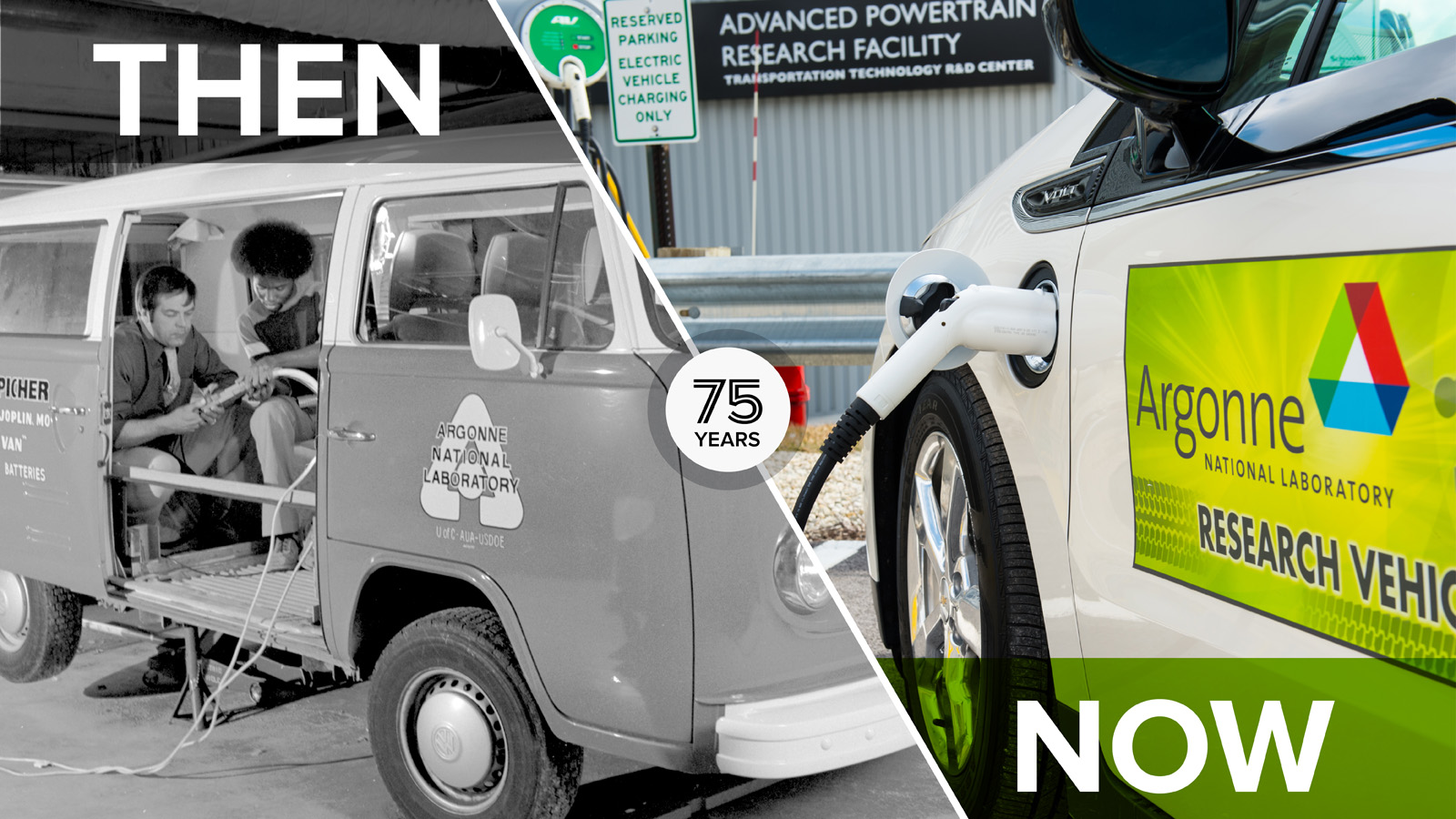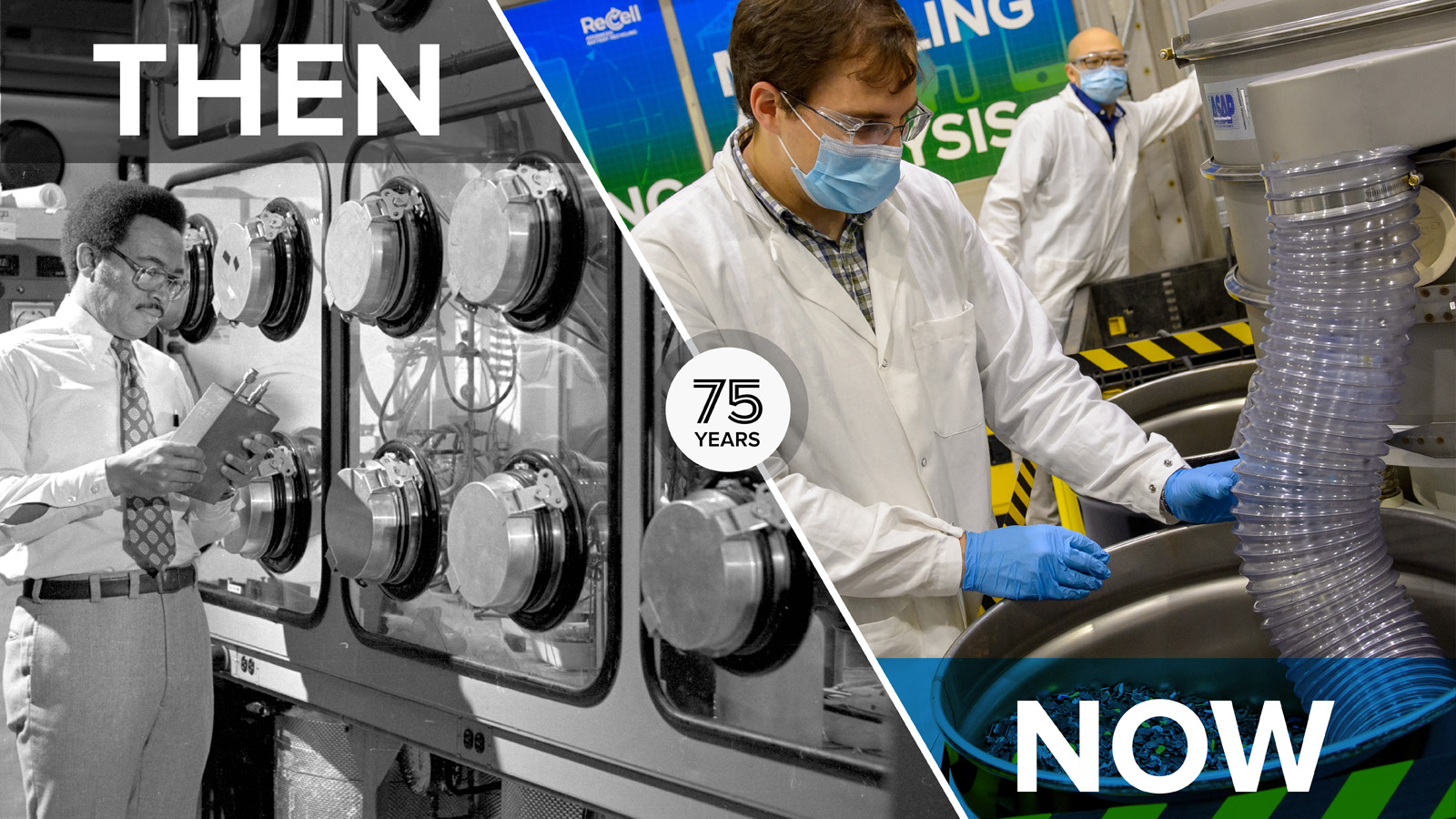Argonne is as committed to breakthrough experiments, cutting-edge innovation and scientific discovery as it was when it helped build the first nuclear reactor more than 75 years ago. It has grown from a science facility housed in temporary laboratories to an internationally renowned scientific institution. Each year, Argonne’s 1,400 researchers – and the nearly 7,000 scientists from academia, industry, and government laboratories who use the laboratory’s large-scale facilities – drive discoveries that change the world as we know it and provide for the nation’s sustainable energy needs, economic prosperity, and security.
This set of “then and now” photo collages provides a peek into Argonne’s past and present research and operations—and allows you to imagine where Argonne may take science over the next 75 years.
Argonne’s visionary efforts starting in the 1970s to develop and test new types of batteries helped kick-start a transformation of the automotive market. Today, Argonne’s battery research is critical to the global fight against climate change, as automotive manufacturers around the world transition to electric vehicles to reduce greenhouse gases.
Argonne broke barriers in 1963 with the Zero Gradient Synchrotron, the nation’s first proton accelerator for high-energy physics research. Today, Argonne is upgrading its Advanced Photon Source (APS) user facility, which will generate X-ray beams up to 500 times brighter than the current facility.
When pushing the frontiers of science, there is no such thing as “off the shelf.” Engineers and machinists in Argonne’s Central Machine Shop were renowned for precision parts, custom components, and complicated machine repairs. Their tradition continues with engineering and designing advanced unique high-precision tools in Argonne’s Custom Manufacturing Solutions-Central Shops.
Progress has been anything but small at Argonne. At Argonne’s Center for Nanoscale Materials (CNM), scientists collaborate on nanoscience and nanotechnology for society’s benefit, researching artificial intelligence, the potential of superconductors, and new potential treatments for complex neurological disorders.
Argonne’s Lemont, IL site has undergone considerable change in the past 75 years. Temporary modular buildings for housing and laboratories gradually gave way to permanent structures, including the Materials Design Laboratory building and the 156-room Argonne Guest House, which hosts scientists from around the world as they conduct cutting-edge, collaborative research.
Research at Argonne promotes U.S. prosperity and security — scaling scientific discoveries from laboratories to industrial-level use is critical. Ongoing work at the Materials Engineering Research Facility (MERF), including development of a new generation of battery materials, allows Argonne to de-risk technologies and processes so industry can increase U.S. competitiveness.
Always at the forefront of computer science, Argonne will soon unveil Aurora, an exascale computer that can perform a billion billion – or one quintillion – calculations per second. Aurora will advance brain and cancer research, predict city-scale or regional effects on climate change, and provide a sharper tool for every field of science.
Argonne’s Zero Gradient Synchrotron (ZGS) was a hub for high-energy physics research. Now retired, the ZGS is an Education and Outreach Learning Center where Argonne inspires the next generation of scientific problem solvers to use code and robots to solve real-world challenges. The laboratory also had a cameo in the 1996 film Chain Reaction.
From 1957 to 1972, Argonne used ARGOnne Nuclear Assembly for University Training (ARGOnaut) to teach reactor theory and nuclear physics to students from more than 40 countries. Today, the Argonne Tandem Linac Accelerator System (ATLAS) supports 200 to 300 researchers annually as they study nuclear physics, the core of matter and the fuel of stars.
Argonne researchers used a classic chemistry kit to build an atomic model of the Bence-lones protein, which shed light on the three-dimensional structure of antibodies. Today, Argonne’s computerized models use data from the Advanced Photon Source to examine the protein structure of the virus that causes COVID-19 and to guide medical responses to disease.
From presidents onsite to cabinet secretaries on virtual visits, Argonne advances U.S. prosperity and security by engaging leaders and decision makers in conversation about cutting-edge energy research and development. With this knowledge, the country pursues the vehicle technology, energy storage, water purification, and decarbonization goals (and more) that keep a beautiful America a competitive America.
Did you know that some radioisotopes are created in nuclear reactors or particle accelerators? Argonne’s early nuclear research laid the groundwork for the Low-Energy Accelerator Facility (LEAF), which produces a wide range of useful radioisotopes for medical, national security, basic science and industrial uses, continuing the quest to use nuclear energy for peaceful purposes.
Argonne’s early battery research affected not only American automotive manufacturing but also the worldwide electronics market. Today, Argonne’s ReCell Center focuses on innovative and effective lithium-ion battery recycling, which is key to U.S. competitiveness in the global recycling industry and important for reducing reliance on foreign sources of battery materials.
From the use of classic weather balloons to sophisticated radars and modeling tools, Argonne researchers over the years have led the way in climate change analysis. Today, Argonne works with industry, such as companies like AT&T, to use its datasets to pinpoint extreme weather conditions and understand their potential impact.
Gamma ray lenses helped identify black holes and neutron stars, and Argonne physicist Robert Smither (left) pioneered the use of a gamma ray detector to look inside the human body without damaging it. Today, superconducting transition-edge sensors fabricated at Argonne enable exploration of the Cosmic Microwave Background, the radiation presumed leftover by the “Big Bang.”
Argonne is as committed to breakthrough experiments, cutting-edge innovation and scientific discovery as it was when it helped build the first nuclear reactor more than 75 years ago. Today, Argonne leverages multi-disciplinary teams, world-class facilities, and powerful scientific tools to confront some of the most profound scientific and technological challenges including quantum information science.















